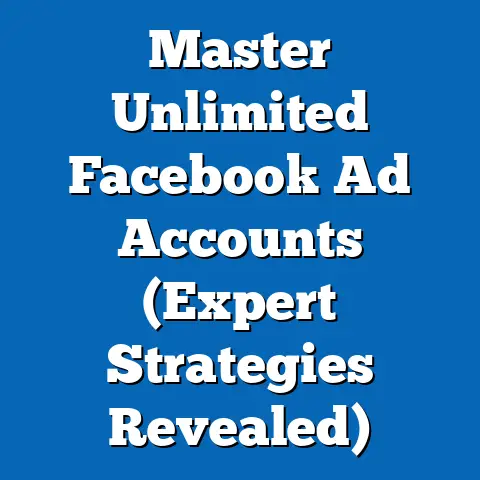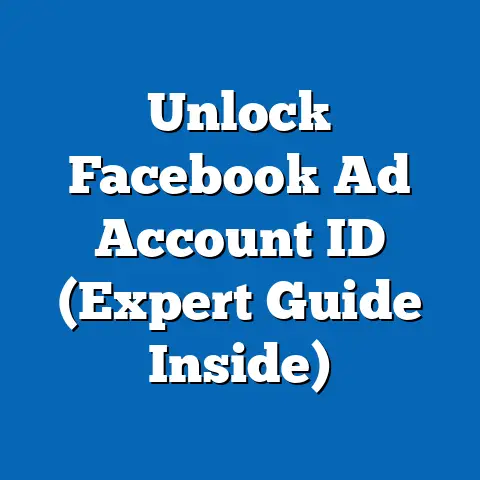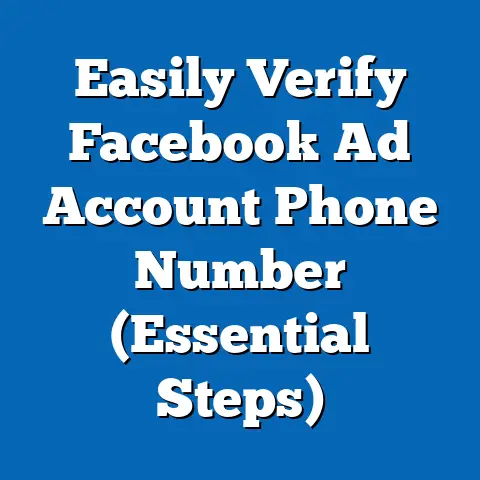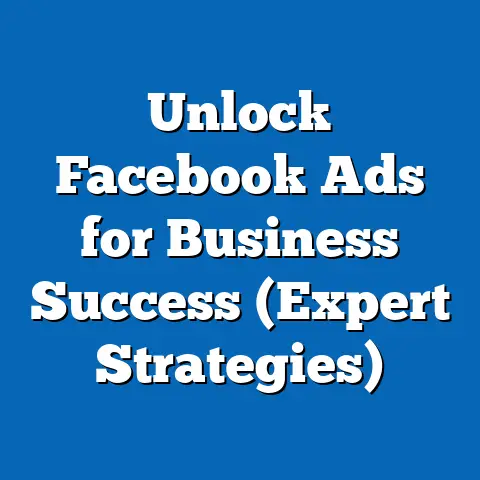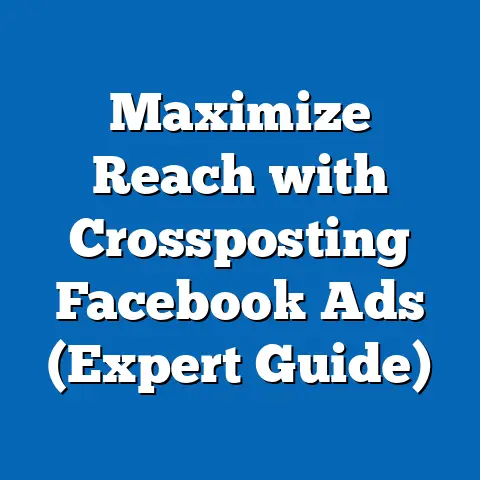Boost Business with Atlanta’s Top Facebook Ads (Expert Tips)
In today’s fast-paced digital world, capturing and maintaining customer attention is more challenging than ever. With the rise of social media, platforms like Facebook have become crucial battlegrounds for businesses vying for visibility and engagement. For Atlanta-based businesses, understanding and leveraging Facebook ads is no longer an option—it’s a necessity.
I’ve spent years helping businesses, both big and small, navigate the complexities of Facebook advertising. I’ve seen firsthand how a well-crafted campaign can transform a struggling business into a thriving one. This article is designed to provide you, the Atlanta business owner or marketing professional, with the expert tips and strategies you need to optimize your Facebook advertising and drive real results.
We’ll delve into the current trends shaping the Facebook advertising landscape, understand your audience, craft compelling ad content, and implement effective targeting strategies. We’ll also explore the various ad formats available and, most importantly, how to measure and analyze your ad performance to ensure you’re getting the best possible return on your investment. Let’s get started on the journey to boosting your business with Atlanta’s top Facebook ads!
Current Trends in Facebook Advertising
Facebook continues to be a dominant force in the advertising world, and its relevance is especially pronounced for local businesses in Atlanta. Recent statistics highlight the platform’s significance: as of 2023, Facebook boasts over 2.9 billion monthly active users, a massive audience ripe with potential customers. For Atlanta businesses, this translates to an unparalleled opportunity to reach local consumers with targeted, engaging ads.
I’ve observed some interesting shifts in how businesses are using Facebook ads. Let’s explore some of the major trends:
Personalized Advertising
One of the most significant trends I’ve seen is the rise of personalized advertising. Generic ads are becoming less effective as consumers demand more relevant and tailored experiences. Facebook allows advertisers to create highly personalized ads based on user data like demographics, interests, and behaviors.
Why it matters: Personalized ads resonate more deeply with audiences, leading to higher engagement rates and conversions.
Example: An Atlanta-based fitness studio could create ads targeting specific neighborhoods, showcasing workout classes tailored to different age groups or fitness levels.
Video Content
Video content continues to dominate the digital landscape, and Facebook is no exception. Video ads are highly engaging and can convey complex messages in a short amount of time. I’ve found that videos often outperform static images in terms of click-through rates and overall engagement.
Why it matters: Video ads capture attention and are more likely to be shared, expanding your reach.
Example: A local restaurant could create a short video showcasing their signature dishes and the vibrant atmosphere of their dining space.
Mobile-First Strategies
With the majority of Facebook users accessing the platform via mobile devices, a mobile-first approach is essential. I always emphasize the importance of designing ads that look great and function seamlessly on smartphones and tablets.
Why it matters: Mobile-optimized ads ensure a positive user experience, leading to higher conversion rates and customer satisfaction.
Example: An Atlanta-based retailer should ensure their Facebook ads feature clear images and concise text that are easily viewable on smaller screens.
Impact of COVID-19 on Digital Advertising
The COVID-19 pandemic significantly accelerated the shift towards digital advertising. With lockdowns and social distancing measures in place, consumers turned to online shopping and social media for entertainment and connection. This surge in online activity created a massive opportunity for businesses to reach customers through Facebook ads.
Why it matters: The pandemic has permanently altered consumer behavior, making digital advertising a critical component of any business strategy.
Example: Atlanta-based businesses that pivoted to online sales during the pandemic saw a significant increase in revenue through targeted Facebook ad campaigns.
Facebook Algorithm Changes
Facebook’s algorithm is constantly evolving, and these changes can have a significant impact on ad visibility and targeting. I make it a point to stay updated on the latest algorithm updates and adjust my strategies accordingly.
Why it matters: Understanding the algorithm helps you optimize your ads for maximum reach and engagement.
Example: Recent algorithm changes have prioritized content from friends and family, making it more important than ever to create ads that feel authentic and engaging.
The Rise of Social Commerce
Social commerce, the practice of selling products directly through social media platforms, is on the rise. Facebook Shops and Instagram Shopping allow businesses to create virtual storefronts and sell products directly to customers without ever leaving the platform.
Why it matters: Social commerce streamlines the purchasing process, making it easier for customers to buy your products.
Example: An Atlanta-based boutique could set up a Facebook Shop to showcase their latest collections and allow customers to purchase items directly through the platform.
Takeaway: Staying abreast of these trends and adapting your Facebook advertising strategies accordingly is crucial for success in today’s competitive digital landscape. By embracing personalized advertising, video content, mobile-first strategies, and social commerce, Atlanta businesses can maximize their reach and engagement on Facebook. Don’t forget to stay informed about algorithm changes to ensure your ads remain visible and effective.
Understanding Your Audience
Knowing your audience is the cornerstone of any successful marketing campaign, and Facebook advertising is no exception. Without a clear understanding of who you’re trying to reach, your ads are likely to fall flat. In this section, I’ll guide you through the process of understanding your audience and tailoring your ad content to resonate with them.
The Importance of Audience Segmentation and Targeting
Audience segmentation is the process of dividing your target market into distinct groups based on shared characteristics such as demographics, interests, and behaviors. Targeted ads are more likely to resonate with specific segments, leading to higher engagement rates and conversions.
Why it matters: Targeted ads are more relevant to your audience, resulting in higher ROI.
Example: A real estate agency in Atlanta might segment their audience based on age, income, and location to target first-time homebuyers, luxury property seekers, or renters looking to buy.
Using Facebook Audience Insights
Facebook Audience Insights is a powerful tool that provides valuable data on the demographics, interests, and behaviors of your target audience. By analyzing this data, you can gain a deeper understanding of who your customers are and what they care about.
How to use it:
- Access Audience Insights: Go to Facebook Ads Manager and navigate to the Audience Insights tool.
- Define Your Audience: Specify your target audience based on location, age, gender, and interests.
- Analyze the Data: Explore the data to uncover insights about your audience’s demographics, interests, behaviors, and purchasing habits.
Example: An Atlanta-based coffee shop could use Audience Insights to discover that their target audience is primarily young professionals interested in sustainability and local businesses.
Creating Customer Personas
Customer personas are fictional representations of your ideal customers. By creating detailed personas, you can gain a deeper understanding of your customers’ needs, motivations, and pain points.
How to create a persona:
- Gather Data: Collect data from Facebook Audience Insights, customer surveys, and sales data.
- Identify Key Characteristics: Identify the key characteristics that define your ideal customer, such as age, gender, occupation, income, and interests.
- Create a Story: Craft a story that brings your persona to life, including their goals, challenges, and motivations.
Example: An Atlanta-based tech startup might create a persona named “Sarah,” a 30-year-old marketing manager who is looking for innovative solutions to improve her company’s online presence.
Tailoring Ad Content to Resonate with Different Segments
Once you’ve identified your audience segments and created customer personas, it’s time to tailor your ad content to resonate with each segment. This means crafting ad copy, visuals, and offers that are relevant to each group’s specific needs and interests.
How to tailor ad content:
- Understand Your Audience’s Needs: Identify the specific needs and pain points of each audience segment.
- Craft Relevant Messaging: Create ad copy that speaks directly to those needs and pain points.
- Use Compelling Visuals: Choose visuals that resonate with each segment’s aesthetic preferences.
- Offer Targeted Incentives: Provide incentives that are relevant to each segment’s purchasing habits and preferences.
Example: An Atlanta-based car dealership might create separate ad campaigns targeting families, young professionals, and retirees, each featuring different car models and financing options.
Takeaway: Understanding your audience is crucial for creating effective Facebook ad campaigns. By segmenting your audience, using Facebook Audience Insights, creating customer personas, and tailoring your ad content, you can increase engagement rates, conversions, and ROI. Don’t underestimate the power of knowing your customer – it’s the key to unlocking success in Facebook advertising.
Crafting Compelling Ad Content
Now that you have a firm grasp on who your audience is, the next critical step is crafting ad content that grabs their attention and drives action. Compelling ad content is the bridge between your business and your potential customers, and it’s essential to get it right. I’ve seen many campaigns fail simply because the ad copy and visuals didn’t resonate with the target audience. Let’s dive into the key elements of effective ad content.
Key Elements of Effective Ad Copy
Ad copy is the written text that accompanies your ad, and it plays a crucial role in persuading users to click, engage, and convert. Effective ad copy is clear, concise, and compelling. It should highlight the benefits of your product or service and include a strong call-to-action (CTA).
Key elements:
- Clarity: Your ad copy should be easy to understand and free of jargon.
- Emotional Appeal: Connect with your audience on an emotional level by addressing their needs and pain points.
- Strong CTA: Tell users exactly what you want them to do, whether it’s “Shop Now,” “Learn More,” or “Sign Up.”
Example: An Atlanta-based bakery could use ad copy that highlights the delicious taste and fresh ingredients of their pastries, while also emphasizing the convenience of online ordering and delivery.
The Role of Visuals in Facebook Ads
Visuals, including images and videos, are the first thing users see when they encounter your ad. High-quality visuals are essential for capturing attention and conveying your brand’s message.
Key considerations:
- High-Quality Images: Use crisp, clear images that are visually appealing and relevant to your brand.
- Engaging Videos: Create short, engaging videos that showcase your product or service in action.
- Brand Identity: Ensure your visuals are consistent with your brand’s overall aesthetic and messaging.
Example: An Atlanta-based clothing store could use high-quality images of models wearing their latest collections, showcasing the style and quality of their clothing.
Tips for Writing Engaging Headlines and Body Copy
Headlines and body copy are the bread and butter of your ad content. They need to be concise, engaging, and persuasive.
Tips for writing engaging headlines:
- Use Numbers: Numbers grab attention and convey specific information (e.g., “5 Tips for a Perfect Lawn”).
- Ask Questions: Questions pique curiosity and encourage users to click (e.g., “Are You Ready to Transform Your Home?”).
- Highlight Benefits: Focus on the benefits of your product or service (e.g., “Get a Flawless Complexion with Our New Serum”).
Tips for writing engaging body copy:
- Keep it Concise: Get straight to the point and avoid unnecessary jargon.
- Highlight Key Features: Focus on the most important features of your product or service.
- Use Social Proof: Include testimonials or reviews to build trust and credibility.
Example: An Atlanta-based landscaping company could use a headline like “5 Tips for a Lush, Green Lawn” and body copy that highlights their expert services and positive customer reviews.
Examples of Successful Ad Campaigns from Atlanta Businesses
To illustrate these concepts, let’s look at some examples of successful ad campaigns from notable Atlanta businesses:
- Delta Air Lines: Delta often uses Facebook ads to promote special deals and destinations, showcasing stunning visuals and highlighting the benefits of flying with Delta.
- The Home Depot: The Home Depot uses Facebook ads to promote seasonal products and DIY projects, offering helpful tips and tutorials.
- Chick-fil-A: Chick-fil-A uses Facebook ads to promote new menu items and special events, engaging customers with playful visuals and witty copy.
Takeaway: Crafting compelling ad content is a blend of art and science. It requires a deep understanding of your audience, a keen eye for design, and a knack for persuasive writing. By focusing on clarity, emotional appeal, high-quality visuals, and engaging headlines, you can create Facebook ads that capture attention, drive engagement, and ultimately, boost your business. Remember to always A/B test your ad content to see what resonates best with your audience.
Utilizing Facebook Ad Formats
Facebook offers a variety of ad formats to suit different campaign goals and creative preferences. Understanding the strengths and weaknesses of each format is crucial for maximizing your ad’s impact. In this section, I’ll walk you through the various ad formats available on Facebook and provide guidance on when to use them.
Overview of Facebook Ad Formats
Facebook offers a diverse range of ad formats, each designed to achieve specific marketing objectives. Here’s a quick rundown:
- Image Ads: Simple and effective, image ads feature a single image or graphic with accompanying text. They’re ideal for showcasing products, services, or brand messaging.
- Video Ads: Highly engaging, video ads capture attention and convey complex messages in a dynamic format. They’re perfect for storytelling, product demos, and behind-the-scenes glimpses.
- Carousel Ads: Carousel ads display multiple images or videos in a scrollable format, allowing you to showcase multiple products or features in a single ad.
- Slideshow Ads: Similar to video ads, slideshow ads combine multiple images with music or text to create a visually appealing presentation.
- Collection Ads: Collection ads are designed for e-commerce businesses, allowing you to showcase a catalog of products in a visually rich format.
- Instant Experience Ads: Instant Experience ads (formerly Canvas ads) provide a full-screen, immersive experience on mobile devices. They’re ideal for storytelling, product demos, and interactive content.
- Lead Ads: Lead ads make it easy for users to sign up for newsletters, request quotes, or download resources directly from the ad. They’re perfect for lead generation campaigns.
- Dynamic Ads: Dynamic ads automatically showcase relevant products to users based on their browsing history and interests. They’re ideal for retargeting campaigns and e-commerce businesses.
Benefits of Each Format and When to Use Them
Let’s delve deeper into the benefits of each ad format and when to use them:
- Image Ads:
- Benefits: Simple, cost-effective, and easy to create.
- When to Use: When you have a strong visual and a clear message to convey.
- Video Ads:
- Benefits: Highly engaging, versatile, and effective for storytelling.
- When to Use: When you want to capture attention, showcase a product in action, or convey a complex message.
- Carousel Ads:
- Benefits: Allows you to showcase multiple products or features in a single ad.
- When to Use: When you have a diverse product catalog or want to highlight multiple benefits of your product or service.
- Slideshow Ads:
- Benefits: Visually appealing, cost-effective, and easy to create.
- When to Use: When you want to create a dynamic presentation of your product or service without the expense of video production.
- Collection Ads:
- Benefits: Showcases a catalog of products in a visually rich format, driving e-commerce sales.
- When to Use: When you have an e-commerce business and want to showcase your product catalog to potential customers.
- Instant Experience Ads:
- Benefits: Provides a full-screen, immersive experience on mobile devices, engaging users with interactive content.
- When to Use: When you want to tell a compelling story, showcase a product demo, or provide an interactive experience.
- Lead Ads:
- Benefits: Makes it easy for users to sign up for newsletters, request quotes, or download resources, generating valuable leads.
- When to Use: When you want to generate leads for your business and build your email list.
- Dynamic Ads:
- Benefits: Automatically showcases relevant products to users based on their browsing history, increasing the likelihood of a sale.
- When to Use: When you want to retarget website visitors or showcase relevant products to potential customers.
- Benefits: Simple, cost-effective, and easy to create.
- When to Use: When you have a strong visual and a clear message to convey.
- Benefits: Highly engaging, versatile, and effective for storytelling.
- When to Use: When you want to capture attention, showcase a product in action, or convey a complex message.
- Benefits: Allows you to showcase multiple products or features in a single ad.
- When to Use: When you have a diverse product catalog or want to highlight multiple benefits of your product or service.
- Benefits: Visually appealing, cost-effective, and easy to create.
- When to Use: When you want to create a dynamic presentation of your product or service without the expense of video production.
- Benefits: Showcases a catalog of products in a visually rich format, driving e-commerce sales.
- When to Use: When you have an e-commerce business and want to showcase your product catalog to potential customers.
- Benefits: Provides a full-screen, immersive experience on mobile devices, engaging users with interactive content.
- When to Use: When you want to tell a compelling story, showcase a product demo, or provide an interactive experience.
- Benefits: Makes it easy for users to sign up for newsletters, request quotes, or download resources, generating valuable leads.
- When to Use: When you want to generate leads for your business and build your email list.
- Benefits: Automatically showcases relevant products to users based on their browsing history, increasing the likelihood of a sale.
- When to Use: When you want to retarget website visitors or showcase relevant products to potential customers.
Case Studies of Atlanta Businesses Using Different Ad Formats
- A Local Restaurant: Uses carousel ads to showcase different dishes on their menu, enticing customers with mouth-watering visuals.
- A Real Estate Agency: Uses video ads to showcase luxury properties, providing a virtual tour and highlighting key features.
- A Clothing Boutique: Uses collection ads to showcase their latest collections, allowing customers to browse and purchase items directly from the ad.
Innovative Uses of Facebook’s Ad Features
- Dynamic Ads with Location Targeting: An Atlanta-based retailer uses dynamic ads to showcase products that are available at nearby stores, driving foot traffic to their physical locations.
- Lead Ads with Custom Questions: A local insurance agency uses lead ads to collect information about potential clients, asking custom questions to qualify leads and tailor their offers.
Takeaway: Facebook offers a wide array of ad formats to suit different campaign goals and creative preferences. By understanding the strengths and weaknesses of each format, you can choose the right format for your business and maximize your ad’s impact. Don’t be afraid to experiment with different formats and see what works best for your audience.
Implementing Effective Targeting Strategies
Effective targeting is the key to reaching the right audience with your Facebook ads. It ensures that your ads are seen by people who are most likely to be interested in your products or services. In this section, I’ll guide you through the process of implementing effective targeting strategies on Facebook.
Custom Audiences and Lookalike Audiences
Custom audiences and lookalike audiences are two powerful targeting options that allow you to reach specific groups of people on Facebook.
- Custom Audiences: Custom audiences allow you to target users based on data you already have, such as email lists, website visitors, or app users.
- Lookalike Audiences: Lookalike audiences allow you to reach new users who are similar to your existing customers or website visitors.
How to create a custom audience:
- Go to Facebook Ads Manager: Navigate to the Audiences section.
- Create a Custom Audience: Choose the source of your data, such as a customer list or website traffic.
- Upload Your Data: Upload your customer list or set up a Facebook pixel to track website visitors.
- Match Your Data: Facebook will match your data with Facebook users to create your custom audience.
How to create a lookalike audience:
- Go to Facebook Ads Manager: Navigate to the Audiences section.
- Create a Lookalike Audience: Choose your source audience, such as a custom audience or a Facebook page.
- Select Your Audience Size: Choose the size of your lookalike audience, ranging from 1% to 10% of the total population.
- Target Your Lookalike Audience: Facebook will create a lookalike audience based on the characteristics of your source audience.
Retargeting Website Visitors and Engaging Previous Customers
Retargeting is the process of showing ads to users who have previously interacted with your website or app. It’s a highly effective way to re-engage potential customers and drive conversions.
How to set up retargeting:
- Install the Facebook Pixel: Add the Facebook pixel to your website to track visitor behavior.
- Create a Custom Audience: Create a custom audience based on website traffic or specific actions taken on your website.
- Set Up Your Retargeting Campaign: Create a Facebook ad campaign targeting your custom audience.
Tips for effective retargeting:
- Segment Your Audience: Create separate retargeting campaigns for different segments of your audience, such as users who viewed specific products or added items to their cart.
- Personalize Your Ads: Tailor your ads to the specific products or services that users viewed on your website.
- Offer Incentives: Provide incentives, such as discounts or free shipping, to encourage users to complete their purchase.
Location Targeting Specific to Atlanta Neighborhoods or Demographics
Facebook allows you to target users based on their location, enabling you to reach potential customers in specific Atlanta neighborhoods or demographics.
How to set up location targeting:
- Go to Facebook Ads Manager: Create a new ad campaign or edit an existing one.
- Select Your Audience: Choose your target audience based on location, age, gender, and interests.
- Specify Your Location: Enter the specific Atlanta neighborhoods or zip codes you want to target.
- Refine Your Targeting: Further refine your targeting by specifying demographic characteristics such as age, gender, and interests.
Example: An Atlanta-based coffee shop could target users in specific neighborhoods, such as Midtown or Buckhead, who are interested in coffee, local businesses, or breakfast.
Examples of Businesses Enhancing Ad Reach
- A Fitness Studio: Uses custom audiences to target users who have visited their website or signed up for a free trial, offering them a discounted membership.
- A Clothing Boutique: Uses lookalike audiences to reach new customers who are similar to their existing customer base, expanding their reach and driving sales.
- A Local Restaurant: Uses location targeting to reach users in specific Atlanta neighborhoods, promoting special deals and events.
Takeaway: Effective targeting is essential for maximizing the impact of your Facebook ads. By using custom audiences, lookalike audiences, retargeting, and location targeting, you can reach the right audience with your ads and drive conversions. Don’t underestimate the power of precise targeting – it’s the key to unlocking success in Facebook advertising.
Measuring and Analyzing Ad Performance
Measuring and analyzing your ad performance is crucial for understanding what’s working and what’s not. Without data-driven insights, you’re essentially flying blind. In this section, I’ll guide you through the process of tracking and measuring your ad performance using Facebook Ads Manager.
The Importance of Tracking and Measuring Ad Performance
Tracking and measuring your ad performance allows you to:
- Understand Your ROI: Determine whether your ad campaigns are generating a positive return on investment.
- Identify Areas for Improvement: Pinpoint areas where your ads are underperforming and make necessary adjustments.
- Optimize Your Campaigns: Fine-tune your targeting, ad content, and bidding strategies to improve performance.
- Make Data-Driven Decisions: Base your marketing decisions on concrete data rather than gut feelings.
Key Performance Indicators (KPIs) to Monitor
Key Performance Indicators (KPIs) are metrics that indicate the success of your ad campaigns. Here are some of the most important KPIs to monitor:
- Impressions: The number of times your ad is displayed.
- Reach: The number of unique users who saw your ad.
- Click-Through Rate (CTR): The percentage of users who clicked on your ad after seeing it.
- Conversion Rate: The percentage of users who completed a desired action (e.g., purchase, sign-up) after clicking on your ad.
- Cost Per Click (CPC): The average cost you pay each time someone clicks on your ad.
- Cost Per Conversion (CPC): The average cost you pay for each conversion.
- Return on Ad Spend (ROAS): The amount of revenue you generate for every dollar you spend on advertising.
Setting Up A/B Testing to Optimize Ad Performance
A/B testing, also known as split testing, is the process of comparing two versions of an ad to see which one performs better. By testing different ad elements, such as headlines, images, and CTAs, you can optimize your ads for maximum performance.
How to set up A/B testing:
- Go to Facebook Ads Manager: Create a new ad campaign or edit an existing one.
- Create Two Ad Sets: Create two ad sets with the same targeting options but different ad creatives.
- Test Different Elements: Test different ad elements, such as headlines, images, or CTAs.
- Monitor Performance: Track the performance of each ad set and identify the winning variation.
- Implement the Winning Variation: Implement the winning variation in your ad campaign.
Adjusting Strategies Based on Performance Analytics
The key to successful Facebook advertising is to continuously monitor your ad performance and adjust your strategies based on the data.
How to adjust strategies based on performance analytics:
- Identify Underperforming Ads: Identify ads that are underperforming in terms of CTR, conversion rate, or ROAS.
- Analyze the Data: Analyze the data to understand why the ads are underperforming.
- Make Adjustments: Make necessary adjustments to your targeting, ad content, or bidding strategies.
- Monitor Performance: Continuously monitor your ad performance to ensure your adjustments are having the desired effect.
Example: If you notice that your CTR is low, you might try testing different headlines or images to see if you can improve engagement.
Takeaway: Measuring and analyzing your ad performance is essential for optimizing your Facebook advertising campaigns. By tracking key performance indicators, setting up A/B testing, and adjusting your strategies based on performance analytics, you can maximize your ROI and achieve your marketing goals. Remember, data is your best friend in the world of digital advertising.
We discussed the importance of personalized advertising, video content, and mobile-first strategies, as well as the impact of COVID-19 and Facebook’s algorithm changes. We also emphasized the significance of understanding your audience, crafting compelling ad content, and utilizing Facebook ad formats effectively. Finally, we highlighted the importance of implementing effective targeting strategies and measuring and analyzing ad performance to optimize your campaigns.
Remember, leveraging Facebook ads effectively can significantly boost business growth for Atlanta-based companies. It’s about understanding the platform, knowing your audience, and continuously optimizing your campaigns based on data-driven insights.
I encourage you to implement the expert tips shared in this guide and start experimenting with your Facebook ad strategies. Don’t be afraid to try new things, test different approaches, and learn from your successes and failures. With dedication and persistence, you can unlock the full potential of Facebook advertising and drive real results for your business. So go ahead, take the leap, and start boosting your business with Atlanta’s top Facebook ads today!

